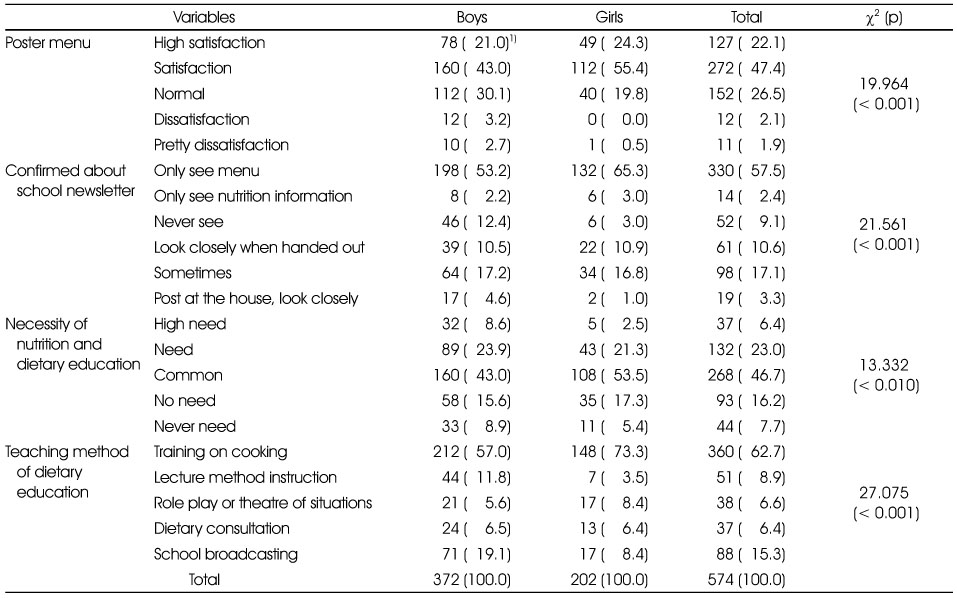References
1. Lee JM, Kang NE, Kim HY, Chung CE, Cho MS, Cho WK, et al. Institutional food service 3rd edth ed. Seoul: Powerbook; 2013. p. 352–353.
4. Cho HS, Choi MK. A study on body image and dietary habits by the body mass index of middle school students in Chungnam. Korean J Food Nutr 2010;23(3):368–375.
5. Han GS, Cho WK. Study of dietary behaviors and snack intake patterns of high school students in Seoul, Incheon, and Gyeonggi-do. J Korean Soc Food Cult 2011;26(5):490–500.
6. Park HW, Chung SJ. Body composition and obesity in Korean adolescents and its impact on diabetes mellitus. Korean J Obes 2013;22(3):137–144.
7. Son SM, Lee KH, Kim KW, Lee Y. Nutrition education and counseling Seoul: Life science; 2010. p. 367.
8. Kwon SW, Song IH. Cognitive distortions as a moderator on the relationship between educational stress and suicidal ideation among middle school students. J Adolesc Welf 2011;13(3):67–92.
9. Jang MH, Lee GJ. Body image dissatisfaction as a mediator of the association between BMI, self-esteem and mental health in early adolescents: a multiple-group path analysis across gender. J Korean Acad Nurs 2013;43(2):165–175.
10. Yun EK, Shin SH. Comparison of the factors influencing young adolescents' aggression according to family structure. J Korean Acad Nurs 2013;43(3):321–330.
11. Na JA, Lee JH, Kim MH. Study on the satisfaction for school food service and dietary habits of middle school students in Sejong special self-governing city. Korean J Food Nutr 2014;27(3):369–382.
12. Kim Y. Adulterated food management characteristics according to dietary lifestyles among adolescents. Korean J Community Nutr 2016;21(6):509–519.
13. Kwon JE, Park HJ, Lim HS, Chyun JH. The relationships of dietary behavior, food intake, and life satisfaction with family meal frequency in middle school students. Korean J Food Cult 2013;28(3):272–281.
14. Lee KA. Comparison of the eating habit, preference and intake frequency of vegetables between middle and high school students in Busan. J Korean Home Econ Educ Assoc 2015;27(4):93–107.
15. Song HJ, Moon HK. Body image, risk of disturbed eating attitudes and weight control of female junior high school students by body mass index in Seoul. Korean J Community Nutr 2014;19(2):111–121.
16. Ko SY, Kim KW. Nutrition label use, self-efficacy, snacking and eating behavior of middle school students in Kyunggi Area. Korean J Community Nutr 2010;15(4):513–524.
17. Cho SE. Research on the dietary habits and satisfaction of school meals of high school students in the Chung Nam area [master's thesis] Gongju University; 2010.
18. Choi MK, Bae YJ, Kim MH, In SJ. A survey of the needs of nutrition education based on analysis of eating habits and nutrition knowledge among middle school students in Kyung-Gi province. J Korean Diet Assoc 2010;16(2):133–145.
19. Oh YM, Kim MH, Sung CJ. The study of satisfaction, meal preference and improvement on school lunch program of middle school boys and girls in Jeonju. J Korean Diet Assoc 2006;12(4):358–368.
20. Chang HS, Park HJ. A study of elementary students' satisfaction in school food service and their dietary behaviors in Gunsan city. Korean J Hum Ecol 2009;18(2):477–489.
21. Kim HJ. Study of satisfaction level on school meal management by high school students [master's thesis] Kumoh National University; 2002.
22. Kim ES. A study on satisfaction and menu preference of school food service in middle school students: focused on Kunsan area, Chonbuk province [master's thesis] Wonkwang University; 2013.
23. Park KJ, Jang MR, Survey on. Survey on satisfaction of fifth and sixth grade students from elementary school food service in Won-ju. J Korean Diet Assoc 2008;14(1):13–22.
25. Park SH, Choe YC. Students' satisfaction of school lunch according to the dietary habit and educational experience of nutrition and food. Fam Environ Res 2015;53(4):425–432.








